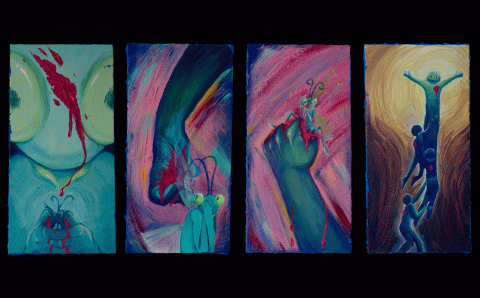Note: This story was originally published in Spark, Dec. 2018.
The woman, swathed in a black dress, sits on the floor of a white-tiled institutional kitchen, big pots stacked behind her and beside her. Broken masonry and other rubble ring her. A light from outside the frame spills over the scene.
“Notice where the light falls.”
Donna Spaan is walking a visitor through an exhibition in Calvin College’s Center Art Gallery. She’s stopped in front of a large photograph by Marina Abramovic.
“The light falls on her hands of service and on her face of contemplation,” she prompts.
“Donna is looking for art that can move people’s thinking away from the urgent and toward the important,” said Craig Hanson, professor of art history at Calvin. “Maybe it’s not surprising that several of the works include skulls—a reminder of our mortality.”
Hanson wrote the introduction to the current exhibition of nine works from The Donna Spaan Collection of Contemporary Art.
These nine, plus 15 other pieces, Spaan has donated to Calvin’s permanent art collection.
And there are more to come.
The collection began with a conversation overheard at a providential moment.
Spaan had recently returned to Grand Rapids after 30 years in Chicago. For 25 of those years, she directed Calvin’s Chicago Semester, which included designing an arts course that introduced students to a new experience of the arts every week, from dance and theater performances to museum visits.
A Calvin English major with an earlier career in acting and directing, she wanted students to grasp “the imaginative approach the arts bring to understanding the world.”
Retired in Grand Rapids, Spaan was looking for a project. In January 2012, she attended the annual worship symposium put on by the Calvin Institute of Christian Worship.
“The timing was very specific and providential,” she said. “In the art gallery, I heard symposium participants—church people—talking intensely together about the artworks on display. They were discussing them in a very literal way. And I thought, ‘Maybe a way to move people out of that worldview would be an art collection that opens up their imaginations.’”
In a sense, it was a quiet, subtle continuation of her Chicago arts seminar in a new place with new participants.
“When Donna first approached me, I talked about how the college’s art collection functions as an educational tool,” said Joel Zwart, director of the Center Art Gallery from 2003 through March 2017. “We have historical works that students can learn a lot from. But at that point we had very little strong contemporary work. I mentioned that gap to her.”
Helping fill that gap fit Spaan perfectly. During her years in Chicago, she had made it a point to see every major exhibition mounted at both the Art Institute of Chicago and the Museum of Contemporary Art.
As she and Zwart began searching the contemporary art markets for pieces to enhance Calvin’s collection, they realized they needed a guiding theme. Donna chose “Light: God’s Eternal Presence.”
“From my work in the theater, I know that light profoundly influences not only what we see, but how we see it,” Spaan said. “It’s a physical force, but it also operates as a spiritual power of illumination. These are energies that work together.”
Abramovic’s photograph of the woman illuminated in the kitchen hangs next to Paul Winstanley’s oil painting of a nearly bare room. The room’s ceiling is high; the two walls shown are white.
Pushed against the side wall is a folding table with one cheap chair. There’s a banged-up cabinet, too, one of its doors swung open. The back wall is split by tall windows, bright light streaming through them, making the white walls shine.
This time the guest doesn’t need Spaan’s prompt to notice the light. “It’s the same light that shines into the kitchen.”
“Notice the painting’s title,” Spaan says. “It’s ‘Art School.’”
“But there are no art materials in the room. Just the table and chair.”
“And the light,” Spaan adds. “Fundamentally, isn't that what we need to create anything?”
“I’m trying to get viewers to focus not, first of all, on subject matter,” Spaan explained, “but on light. If we can first ask, ‘Where is the light leading me in this work? What is the light trying to do?’ then maybe we can be freed a bit from the strictly fact-based approach to the world that dominates our thinking, even in the church. To truly encounter, in our daily lives, the mystery of the divine, we need a bigger approach, a more imaginative worldview.”
When Spaan searches for and considers new work for the collection, she journals extensively. Not only does she ask herself, as she hopes viewers will, what the light is trying to do within a particular work, she also asks how that work speaks to artwork already in the collection.
She wants a piece only if it “talks to” and illuminates other pieces—as, for example, the light streaming into the kitchen echoes the light pouring into the “art school.”
She wants viewers to put the artworks in conversation with each other, too.
“Donna understands that viewers have a role in creating the meaning of a piece,” Hanson said, “and that the meaning can change, depending on what it’s displayed next to.”
Multiple meanings: It’s another way the collection opens the imagination.
Now comprised of 24 works, The Donna Spaan Collection of Contemporary Art will grow and, one day, travel to other venues. For the time being it’s enriching students and guests to the Center Art Gallery.
“These are weighty works by important contemporary artists,” Zwart said. “The collection is an educational tool of utmost quality.”
The education it offers is an education in a more expansive way of knowing. “In the deepest sense,” Spaan said, “God defines himself as light, all kinds of light. Ultimately, the light in these artworks leads us to say with the psalmist, ‘In thy light we see light.’”
About the Author
Gayle Boss is a freelance writer living in Grand Rapids, Mich., where she is a member of Monroe Community Church.







